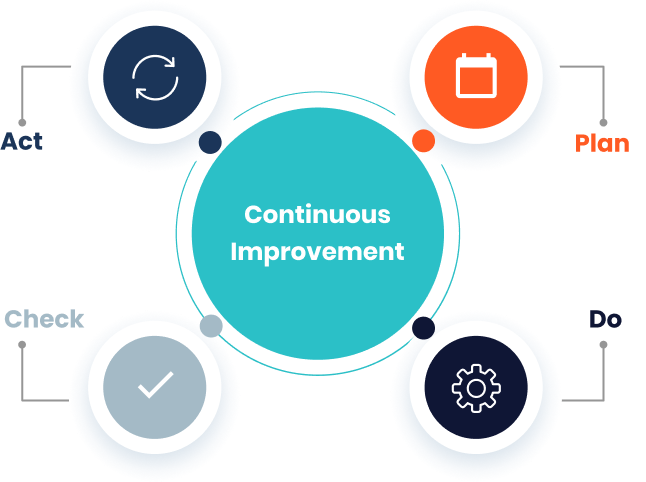
The PDCA cycle in manufacturing
Discover everything you need to know about the plan-do-check-act (PDCA) cycle, a powerful continuous-improvement tool in manufacturing.

What is the PDCA cycle in manufacturing?
The PDCA cycle is a powerful tool used in manufacturing to help organizations achieve continuous improvement. It is a core part of both Lean Manufacturing and Total Quality Management (TQM).
Essentially, the PDCA cycle is a simple, step-by-step model that allows manufacturers to detect, implement, and evaluate improvements. The ultimate goal being to improve processes, prevent mistakes from recurring, and ensure that any changes made are effective and stable.
The Shewhart and Deming Cycle
The PDCA cycle is often referred to as the Shewhart or Deming Cycle.
To explain why, we have to take a quick detour into history.
The PDCA cycle was originally developed in the 1920s by Walter A. Shewhart, an American statistician, physicist, and engineer who worked for Bell Telephone Laboratories. Shewhart was searching for a way to create more dependable manufacturing processes that resulted in higher-quality products with a lower rate of defects.
Shewhart developed PDCA as a structured step-by-step model that allowed his organization to detect, fix, and improve quality issues.

Although it is often claimed that the PDCA cycle was invented by W. Edwards Deming, this is actually not true. Deming was greatly inspired by Shewhart and later expand on his PDCA cycle, integrating it into his Total Quality Management (TQM) philosophy.
Deming played an important role in popularizing the method. He even introduced it to post-war Japan, a country whose manufacturing industry was in crisis at the time.
Deming’s approach to quality management, which includes the PDCA cycle, had a huge impact on Japanese manufacturing and helped it become one of the most successful of the world. He was eventually awarded a prestigious medal by the Japanese government for his contributions to Japan’s industrial success.
The four steps in the PDCA cycle
The acronym PDCA stand for Plan, Do, Check, Act. It represents an iterative and structured approach that covers the entire continuous improvement process, from planning out an improvement project to monitoring the success of solutions.
Let’s quickly review each step of the PDCA process.
1. Plan
The initial stage of a project involves careful planning. Besides identifying the problem that needs to be solved, consider the following:
- The goal to be achieved (in other word, what does success look like?)
- The resources required
- The timeline for completing the project
- The stakeholders who need to be involved
After defining the above and brainstorming possible solutions to the problem, you can move on to the next stage.

2. Do
After completing the planning stage, it’s time to kick off a pilot project. It’s a best practice here to implement changes on a small scale, as unexpected problems may arise.
By executing your project on a small scope, you can avoid any problems that could have a large impact on your operations.
During this stage, it’s important to record insights, data, and other information that can be used to evaluate the project later on.
3. Check
During this crucial step, you evaluate the results of your pilot project. By doing so, you can course-correct and revise your solution before implementing it on a larger scale.
Any hiccups, problems, or redundancies that were encountered during the pilot can be corrected or removed.
Additionally, if the solution was not successful at all, this stage could prompt you to discard the project altogether. In other words, instead of continuing on a fraught path, you return to the drawing board (Plan phase).
4. Act
Last but not least, it’s time for action: implement your fully-fledged solution in a full-scope project.
This new way of working will be a baseline for future operations. It is therefore important to standardize the new procedures, document them, and ensure all stakeholders are aware of them.
As a quick side-note, it’s worth emphasizing that digital Knowledge Management tools can keep all personnel informed of any changes by sending out instant, factory-wide notifications.
It’s also important to note that the Act phase doesn’t conclude the PDCA process. In true continuous-improvement fashion, all stakeholders should continue looking for ways to improve the process even more.
Related Articles


